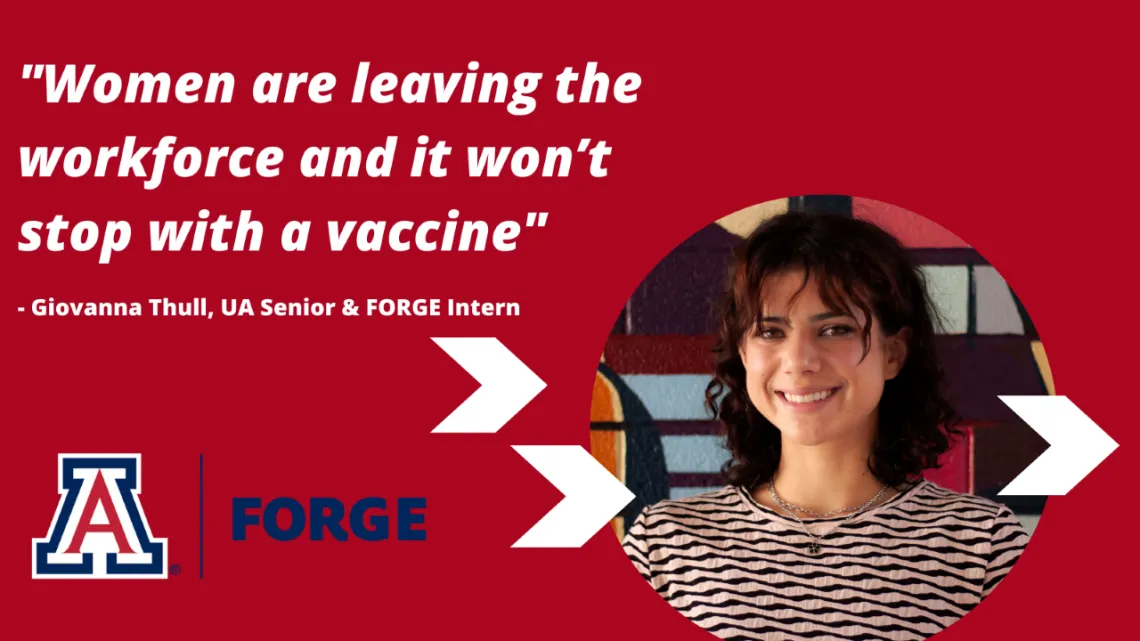Women are Leaving the Workforce and it Won’t Stop With a Vaccine

Hi! Giovanna Thull here.
I am an intern at FORGE and a senior at the University of Arizona majoring in neuroscience and cognitive science.
It was such an honor to write this piece and be given the opportunity to share it with all of you. I hope you enjoy reading, learn as much as I did, and get an idea of what we can do to combat this issue.
Women are leaving the workforce at four times the rate as men.
When I came across this statistic in the course of my research for FORGE, it felt like a punch in the gut.
As a woman pursuing a STEM major and about to enter the workforce, I knew I would encounter challenges. But this statistic feels like it was coming straight out of the 1950s. Growing up, I was aware that success in the workforce was harder to achieve for women than men, but these challenges always felt abstract and far away. My mom is a college professor, and a lot of my own professors at the University of Arizona are highly successful women. The achievements of these women made me feel as though barriers in the workforce were details in a history book. They were plotlines from a story of the past. But as I dived deeper into what the pandemic is revealing about systemic gender inequality, I realized that this is a story of the present.
Why are more women leaving the workforce today than men since the pandemic started?
In my research, I found overwhelming evidence that it has to do with the multiple and intersecting oppression women have always faced.
Disproportionate Housework and Childcare duties
Obviously not every woman desires motherhood, but for those who do, achieving a balance between family and work can be very difficult. And the pandemic has only exacerbated these challenges. For instance, mothers are more than three times as likely as fathers to be responsible for most of their family's housework and childcare during Covid-19. Mothers with young children have reduced their work hours four to five times more than fathers, and the gender gap in work hours has grown by twenty to fifty percent.
Alarming statistics such as these are due to the fact that childrearing responsibilities in heterosexual relationships are still more likely to fall on women. Although efforts have been made to include more mothers in the workforce, and more fathers in childrearing, a 2012 study by the US Department of Labor found that married mothers do almost double the amount of household chores and parenting as do married fathers. Add to that the extra pressures on households for homeschooling children during the pandemic. Covid-19 related school closures are increasing these responsibilities, and many women are finding it practically impossible to do childcare while working from home.
Single mothers, along with women in senior-level positions, are finding these new obstacles imposed by Covid-19 especially difficult. For single-income mothers, paying for childcare may simply not be achievable, and many daycare centers are now closed. Because of this, single mothers are often required to raise their children alone while managing their careers. However, many single mothers are forced to cut back on their work in order to look after their children. This puts them in a difficult situation, as Covid-19 related government assistance is becoming harder to attain. Women in all workplaces are experiencing extra pressure because of Covid-19, but mothers in senior-level positions face an added burden. They are twice as likely as women at other levels to be the only woman in the room thus carrying the weight of their singularity and the resulting extra scrutiny with them. These combined challenges inevitably lead to burnout. Mothers in senior-level positions are 1.5 times more likely to consider leaving their jobs or downshifting. Three in four cite burnout as the reason for considering their career change.
Racial injustice and inequity
Not only is Covid-19 making inequalities between men and women more apparent, but it is also shining light on deeply rooted systematic racism in America. Thirty-three percent of people who have been hospitalized because of Covid-19 are Black, yet only thirteen percent of the U.S. population is Black. Nine percent of white adults personally know someone who has died of Covid-19, while thirty-one percent of Black adults do.
Women of color are also overrepresented in jobs taking the hardest hits because of Covid-19. Black women are nearly twice as likely as white men to say that they’ve been laid off, furloughed, or had their hours and/or pay reduced because of the pandemic. Of the 865,000 women who left the workforce between August and September, 324,000 were Latina, while 58,000 were Black women. Comparatively, 216,000 men left the workforce in that same period. Job loss is also particularly troubling for mothers of color as they are almost twice as likely to be single mothers.
The prejudices women of color have always faced are now amplified by disproportionate loss of livelihood and life from the pandemic. George Floyd’s murder and the resulting unrest and activism reminded the nation of the ways communities of color, especially women of color, suffer from the physical and psychological effects of a system designed to marginalize them. Women of color are also often “onlys” in the workplace, and their experiences may not be readily shared, communicated, or understood by their peers. Being the only woman or woman of color in the workplace contributes to increased experience of microaggressions and the need to provide additional evidence of competence.
Wage Gap and Job Loss
While experience and severity vary, a vast majority of women are confronting increased barriers in the workforce because of Covid-19. This is due to America’s historical and systemic legacy of sexism. Women still earn less than men, are overrepresented in low wage jobs, and are underrepresented in leadership positions.
These discrepancies have always been an issue, but when combined with the unprecedented job loss due to the pandemic, the outcome for women is disastrous. For instance, because women in heterosexual relationships are more likely to earn less than their male counterparts, they are more likely to leave the workforce in order to decrease Covid-19 exposure and/or take care of the growing amount of work at home. Additionally, unlike in many past recessions, layoffs and furloughs are largely concentrated in female-dominated industries like hospitality, education, entertainment and health care. Combined with the aforementioned outside pressures, more women are considering forgoing their careers.
What can we Do?

Clearly, the COVID-19 pandemic has exacerbated the systemic oppressions preventing women from reaching their full potential in the workforce.
But unlike COVID-19, these barriers are neither novel, nor will they go away with a vaccine.
Therefore, even with a vaccine in sight, I think it is imperative that companies take measures to combat gender inequity in the workforce now.
This list is far from complete. It does not address all the measures needed to dismantle the systems responsible for sexism. But for now, here are a few things I think companies can do to address this issue.
- Awareness: First, awareness of sexism in the workforce is crucial. This issue can only be solved if employers recognize its presence, pervasiveness, and the tangible ways it manifests in workplaces. Because many women may not feel comfortable or safe expressing the challenges they are facing, it is important for company leaders to acknowledge these barriers in order to remedy them. Bias training, research, and empathy are all ways workforce leaders can foster awareness.
- Communication: Communication is integral to expanding awareness and making sure employees know they are supported. Because every woman’s experience differs, and everyone is impacted by COVID-19 differently, employers need to check in with employees individually in order to create effective solutions. In the course of my research, I also found that many resources available to employees are not being taken advantage of due to a lack of communication. For instance, almost all companies offer mental-health counseling, but only about half of employees know this benefit is available.
- Representation: Both communication and awareness can be better achieved if women, especially women of color, are represented in leadership positions. Actively pushing towards representation is paramount as representation minimizes gender bias, allows women to feel a greater sense of belonging, and empowers women to advance their carriers. Having women, particularly women of color, in senior level positions also promotes diversity throughout the workforce by demonstrating equitable paths to advancement. Furthermore, research has shown that tokenism isn’t enough. There needs to be at least three women on companies’ board of directors for them to be appreciated as equal members.
- Sustainability: Women all across the board are experiencing unprecedented levels of burnout. Are pre-pandemic productivity standards meaningful? How can they be adjusted to be more realistic and sustainable? I think that, in order to foster productivity during this time, companies must take steps to prioritize mental health. Norms surrounding production need to be reevaluated and adjusted. Companies must work with employees to establish boundaries between work and home in order to mitigate the feeling of being “always on”. Time off is necessary, especially for parents. Because mothers are overburdened and vulnerable to burnout, companies should focus on creating solutions including childcare support, flexible hours, and paid time off.
I was disheartened and dismayed to learn what COVID-19 revealed about sexism in America. But as a woman, I’ve known for a while that sexism is alive and well even though my privilege has sheltered me from much of the greatest hardship. But because of the powerful women who came before me, I don’t feel hopeless, in fact, I feel empowered to carry on their legacies. I have faith that continued progress is possible, and that I will continually and actively work towards achieving justice.
History is now, and women and their allies must be vigilant in advancing gender equity in the workforce.
| - Giovanna Thull |

